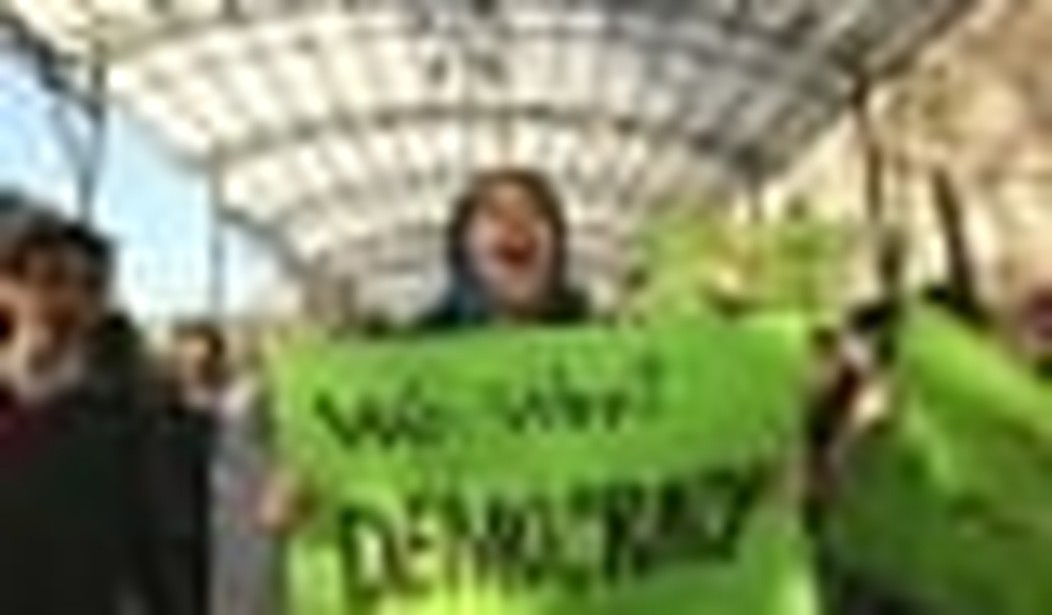Over the past week, Iranians bravely challenged the regime, including protesting on the anniversary of the July 9, 1999, student uprising that was bloodily put down. Universities in Tehran were on alert and armed security personnel deployed. Clashes erupted, with demonstrators in some cases repelling the thugs. Last week’s events show that the opposition Green Movement is still alive. Not only is it evolving as it learns how to cope with security measures, it is also gaining steam as the potential for a regime-killing workers’ strike becomes a real possibility.
Helicopters flew overhead in Tehran to spot gatherings of people that would then be dispersed by the security forces using batons, tear gas, and even knives and brass knuckles. Text message services were disrupted. Most groups were of 20 to 30, but there were moments where hundreds were together like at universities in Mashhad and Ahwaz. One report says about 200 protestors were able to come together and force the Basiji forces back at Seyed Khandan Bridge at Vali-e-Asr Square. The security forces returned and fired tear gas, and went so far as to arrest people who looked back as they dispersed. In another incident, agents harassing three women had to flee when they were confronted. People were detained who were seen using cell phones in the area between Vali-e-Asr Square and Tehran University, where protestors were also active.
The days leading up to the July 9 anniversary were more important than the actual event. The Tehran bazaar closed to protest a reported 70 percent tax increase on them. The regime then said they really meant 30 percent, and then backed down completely. Merchants in Isfahan and Tabriz also shut their doors, forcing the regime’s agents to attack them. One fabric merchant died from a stab wound on July 7. Others reported that their products were thrown out and glass items were smashed. It won’t be easy for the regime to win back the merchants after that aggression. The ferocious reaction of the regime and its ultimate retreat from a tax increase show that a strike by those in the bazaars, especially around the time of political protests, makes them shiver.
If the bazaar strike can unite with a strike by the general workers and political activists, the regime may be doomed — and the regime’s actions over the past week only serve to show they agree. As the Associated Press reports, “For decades, the ruling theocracy has counted on the thousands of bazaar families and businesses as some of their most stalwart backers.”
The near future may bring about such a common front. Factories are closing throughout Iran, and workers are being laid off or working for months in the hopes of one day being paid. There have been sporadic strikes. The regime has been talking about reducing gas subsidies, which could increase the price by six times. When the regime tried to ration fuel in 2007, gas stations were set on fire and there was violent uproar.
Professor Mehrzad Boroujerdi of Syracuse University told the AP, “If gas prices go up, that means the cost of transportation goes up and that means goods cost more. This part is crystal clear. But is it going to translate into political dissent from the bazaar? We don’t know yet. The jury is still out.”
Reports from Iran show that translation is underway. The bazaar merchants’ chants against the regime were more political in nature than economic. According to one report, over 500 of the merchants protested the regime, yelling slogans like “Death to Dictatorship,” “Death to Khamenei,” and “Death to Ahmadinejad.” They were joined by students, indicating that the forming of a common front is being stalled more by difficulties in coordination than in solidarity. Indeed, on July 6, a group of workers from different sectors released a statement expressing their support of the merchants.
A nationwide strike should be the next goal for the Iranian opposition and the West; a task that shouldn’t be too hard since the regime’s self-induced injuries are doing a lot of the work to make this happen. The problems in coordinating a strike can be overcome with Western assistance. Helping the Iranians transmit and receive information needs to be a top priority. The West also needs to shake the confidence of Basiji and Revolutionary Guards guns for hire that think they are on the winning side and that it is in their personal interests to align with a well-paying regime.
Congress should pass legislation that would require the Obama administration to publish of a list of regime personnel involved in attacking the Iranian people so their assets can be frozen. Similar reports about those engaged in corruption should be published and acted upon. The West should say it supports Mousavi in calling for the prosecution of those involved in electioneering and human rights violations, and that their trial is a matter of not if but when. Identified members of the Revolutionary Guards and Basiji should find that their bank accounts are frozen and several zeroes from their bank accounts have mysteriously vanished. The point is to make aligning with the regime a very bad financial and personal investment.
The West could also call upon labor unions and non-profits to help set up strike funds so protestors can decline to go to work but still meet their needs. And as things reach a critical mass, perhaps an olive branch can be offered by the opposition to those who see the writing on the wall and refuse to follow the regime’s orders. The security forces shouldn’t feel as though their lives depend upon the survival of the regime — nor should they feel that the day they are held accountable isn’t inevitable.
The lesson of the last week is that the Iranian government’s biggest fear has been identified and needs to be exploited: and that’s the sparking of a workers’ strike that includes the bazaars.









Join the conversation as a VIP Member